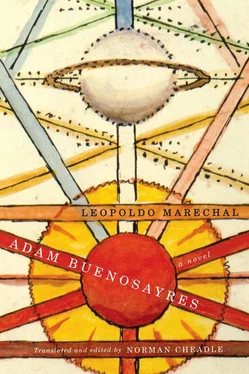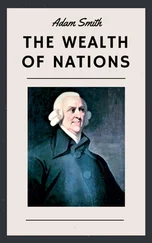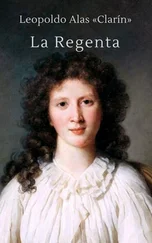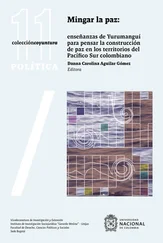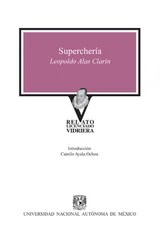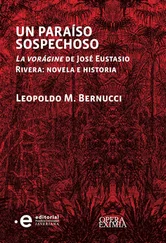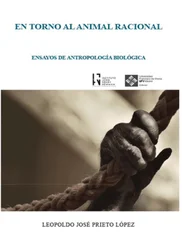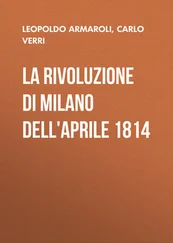21 Although his article is titled “Antisemitism in Modern Argentine Fiction,” Schwartz does not even mention Adán , either because he considers the novel unremarkable in this regard or because he was not aware of its existence — a distinct possibility, given that most of the North American academy scrupulously ignored it. The Argentine-Israeli critic Leonardo Senkman, however, did consider the question: “Obviously, it is not our intention to include Marechal among that fanatical and militant fraction of Catholic intellectuals who at that time raged as much against the capitalism-of-Jewish-gold as against its mythical inversion, the Bolchevik-Jew” (10), though he does point out that the sin of avarice, in the Plutobarrio of Cacodelphia, is satirically condemned less harshly in the Italian capitalist Don Francisco Lombardi than in the Jewish capitalist Don Moisés Rosenbaum (11–13). Susana Bianchi, in her study of the complex relations between the Catholic Church and Peronism, traces the gamut of positions among Catholics in the thirties and forties, from integristas [authoritarian fundamentalists] to the católicos democráticos , inspired by Jacques Maritain’s Humanisme intégral (1939); the former tended toward varying degrees of anti-Semitism, the latter conscientiously rejected the prejudice (Bianchi 39–51; see also Cheadle, “Twentieth-Century homo bonaerense ,” 19–21).
22 Sur published Kahn’s article in February 1948, a few months before Marechal’s novel came out in August. Eduardo González Lanuza’s attack appeared in the November issue of Sur 169 (1948): 87–93.
23 For example, Juan José Sebreli gleefully celebrates a provocation he attributes to Borges, who once “dared to proclaim over Christmas that he didn’t celebrate it because he wasn’t religious, and if he were religious he wouldn’t be Christian, and if he were Christian he wouldn’t be Catholic” (341). Sebreli quotes Borges indirectly, and I have not been able to track down the original comment.
24 Samuel Tesler is perhaps Marechal’s most engaging character. Abelardo Castillo, in his novel El que tiene sed (1985) [He Who Is Thirsty], named his protagonist Jacobo Fiksler, thus honouring both the real-life poet Jacobo Fijman and the philosopher of Adán Buenosayres . Rodolfo Fogwill, in his novel Vivir afuera (1998) [Life Outside], invents for Samuel Tesler a fictional nephew, a Jewish doctor from Villa Crespo called Saúl Schonfeld, who wonders whether or not his crazy uncle was a Peronist (172).
25 Late in life, when discussing the evolution of his novel, Marechal pointed to Don Quixote as his model for Adán and recalled reading it even as a child: “Ever since that time I thought that the paradigm of the novelist was Cervantes, and the paradigm of the novel was, of course, Don Quixote ” ( Autobiografía 63).
26 See Mario Boido’s interesting discussion of these pieces (42–8).
27 Solanas’ road movie El viaje (1992) [The Trip] has a strong Marechal flavour. His best-known film outside Argentina (aside from his 1968 agitprop documentary La hora de hornos ) is Sur (1988), with original music by Astor Piazzolla. In an interview with Horacio González, he allows that Adán Buenosayres could have influenced this film, since he is “a great admirer of Marechal” and “likes to tell stories the way [Marechal] does” (Solanas 93–4). Eliseo Subiela gave the name Leopoldo to the protagonist of his film No te mueras sin decirme adónde vas (1995) [Don’t Die Without Telling Me Where You’re Going], in homage to the author of “the great adventure of Adán Buenosayres ” (Subiela 48).
28 Fernando J. Varea. Entrevista a Manuel Antín. Espacio Cine . 6 Dec. 2009. Accessed 7 Dec. 2009. http://espaciocine.wordpress.com/.
29 I am particularly grateful to Nicola for having dissuaded me from rendering the euphonious title “El Cuaderno de Tapas Azules” (as difficult to do in Italian, apparently, as in English) as The Blue Notebook. The Wittgensteinian association, as Nicola pointed out, is quite inappropriate, especially since Marechal was surely unaware of the Cambridge philosopher’s work.
THE “INDISPENSABLE PROLOGUE”
1 Martín Fierro (1924–1927) was a brilliant avant-garde literary journal in Buenos Aires in the 1920s, where many subsequently famous writers intervened, among them Jorge Luis Borges, Oliverio Girondo, Francisco Luis Bernárdez, Jacobo Fijman, Raúl González Tuñón, Norah Lange, Marechal himself, the legendary Macedonio Fernández, and others. Caricatures of some of these writers appear in Adán (see note 647n19). Marechal suppressed this note in the 1966 edition of Adán .
2 The Cementerio del Oeste (the Western Cemetery), or La Chacarita , was traditionally the cemetery of the common people, as opposed to the upper-class Cementario del Norte (the Northern Cemetery), or the La Recoleta . My thanks for this information to Alberto Piñeiro of the Museo Histórico de Buenos Aires Cornelio Saavedra.
3 The first sentence of the novel uncannily echoes the first sentence of José Mármol’s novel Amalia (1851): “The fourth of May, 1840, at half past ten at night, six men crossed the patio of a small house on Belgrano Street, in the city of Buenos Aires” (Mármol 3). Both sentences begin by specifying the date and the hour; both introduce in media res narrative action protagonized by a group of six men. The latter element is slightly obscured in English translation. In Marechal: “seis hombres nos internábamos”; in Mármol: “seis hombres cruzaban.” Thus the first sentence of Adán seems to signal Marechal’s parodic intent; Adán can be read, on one level, as a counter- Amalia , an earnest Manichean melodrama serving as a vehicle for an extended diatribe against the regime of Juan Manuel de Rosas (see 635n34). Amalia became a canonical text for the culture informing the modern liberal Argentine nation-state, politically consolidated under the presidency of Bartolomé Mitre (1862–68); a silent movie version of the novel was made in 1914 and a feature-length sound version in 1936 (dir. Luis José Moglia Barth).
4 “Tobiano” refers to the light-and-dark colouring of certain pinto horses. Barcia (144n) reads this allegorically: Buenos Aires is both light and dark, spiritual and material.
5 Villa Crespo is a barrio located in the geographical centre of Buenos Aires. Marechal’s family lived at 280 Monte Egmont Street (now called Tres Arroyos). The Church of San Bernardo still stands at 171 Gurruchaga Street, but the statue of Christ has been repaired.
6 In the original: “los perfectos.” The perfecti , “perfect ones,” were initiates of the heretical Cathar or Albigensian religion. Denis de Rougement translates the term as “les ‘Parfaits’ ” in his book L’Amour et l’Occident (65), which explores the relations between the Cathar heresy in twelfth-century southern France and the poetic tradition of courtly love. René Guénon, an author much read by Marechal, uses the same term in his L’ésotérisme de Dante (1925), citing [Dante Gabriel] Rossetti (1828–1882) and especially [Eugène] Aroux (1793–1859), author of such provocative titles as Dante hérétique, révolutionnaire et socialiste (1854; republished 1939); La Comédie de Dante, traduite en vers selon la lettre et commentée selon l’esprit, suivie de la Clef du langage symbolique des Fiels d’Amour (1856–57). Octavio Paz, in his essay on love and eroticism ( Double Flame 102ff), respectfully disagrees with de Rougemont’s ideas on the Cathar connection to courtly love, but Marechal and his preferred authors — and certainly the quasi-autobiographical Adam Buenosayres — are closer to the former than to the great Mexican essayist. In his “Claves de Adán Buenosayres ,” Marechal refers to the secret sect of the Fedeli d’Amore , who practised the courtly-mystical cult of a symbolic Dame, named by Dino Compagni (1255–1324) as the Madonna Intelligenza or transcendent Intellect (Claves 11). Dante himself refers to “los fieles de Amor” [the faithful in Love] in a commentary on one of his sonnets in the Vita nuova (Dante 567). Late in life, in 1968, Marechal quotes, word for word, the verses from Dante’s Divine Comedy which Guénon cites at the outset of L’ésoterisme de Dante : “O voi che avete gl’intelletti sani, / Mirate la dottrina che s’asconde / Sotto il velame delli versi strani!” (Andrés 35) [O you of sound intellect, / Look to the doctrine that hides / Beneath the veil of these strange verses]. Like Guénon, Marechal then refers to the nineteenth-century authors Rossetti and Aroux, before underlining the importance of Luigi Valli’s Il linguaggio segreto di Dante e dei Fedeli d’Amore (1928–30). Thus the two direct sources for Marechal’s notions on Dante — the secret cult rendered by the Fedeli d’Amore to a transcendental Madonna Intelligenza — were Guénon and Valli. In 1969 Marechal averred in a public conference that “Dante belonged to that mysterious sect called the Fedeli d’Amore , along with Guido Cavalcanti, Cino Da Pistoia… a whole group of metaphysical poets who belonged to a secret organization. But it seems that they were all members of the heterodox sect of the Albigensians, enemies of the Catholic Church, which in their language they called the chiesa corrotta , that is, the corrupted church” (Autobiografía de un novelista 67). The Cathars/Albigensians, of course, were not just heterodox but outright heretics against whom the Roman Church launched a military Crusade (1209–29). That Dante’s cult of Beatrice may have been heterodox or even heretical is a sensitive issue for Adam Buenosayres, Marechal, and his conservative Catholic critics. Barcia, for example, gives rather short shrift to the subject, preferring to emphasize that very little is known about the alleged Fedeli d’Amore (72). In sum, it is significant that the narrator of the Indispensable Prologue discreetly uses the code-word perfectos , a veiled reference to Adam Buenosayres’s mysticopoetic construction of a transcendental feminine Figure in his “Blue-Bound Notebook”; that the narrator renounces the way of the perfecti amounts to a — perhaps equivocal and reluctant — disavowal of the heterodox doctrine of the Fedeli d’Amore .
Читать дальше
